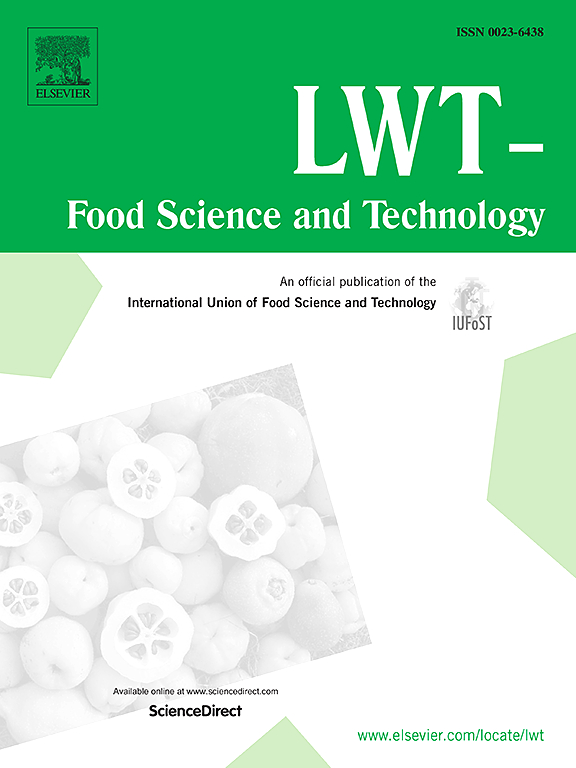Effect of black rice anthocyanins on texture and sensory properties of 3D printed arrowroot starch gel
IF 6
1区 农林科学
Q1 FOOD SCIENCE & TECHNOLOGY
引用次数: 0
Abstract
This study investigated the effects of black rice anthocyanins (BRA) on the properties of 3D-printed arrowroot starch gels (AS gels). BRA exhibited greater stability when embedded in the AS gels. Compared to the control group, where BRA content peaked on day 2 before rapidly degrading, BRA-AS gels showed a delayed peak on day 4, with concentrations 11.91 mg/L higher in dark conditions and 13.06 mg/L higher in light conditions. Color stability analysis confirmed that BRA was effectively retained within the gel matrix, suggested that BRA-AS gels maintained better sensory color stability during storage. Compared to the control AS gels, the BRA-AS gels exhibited higher printing precision, particularly under lower pH conditions. Moreover, the Young's modulus of BRA-AS gels decreased from 204,711 KPa at pH 5.5 to 102,181 KPa at pH 7.0, indicating enhanced resistance to deformation in acidic environments. Texture analysis also revealed improved elasticity of BRA-AS gels under low-pH conditions. Sensory evaluation further supported that BRA-AS gels were softer and more elastic than the controls. These findings support advancements in 3D food printing and functional food development by improving texture, elasticity, and stability.
黑米花青素对3D打印竹淀粉凝胶质地和感官性能的影响
本研究考察了黑米花青素(BRA)对3d打印竹淀粉凝胶(AS凝胶)性能的影响。BRA在AS凝胶中表现出更大的稳定性。与对照组相比,BRA含量在第2天达到峰值,然后迅速降解,而BRA- as凝胶在第4天达到峰值,在黑暗条件下浓度增加11.91 mg/L,在光照条件下浓度增加13.06 mg/L。颜色稳定性分析证实BRA在凝胶基质内被有效保留,表明BRA- as凝胶在储存过程中保持了较好的感官颜色稳定性。与对照AS凝胶相比,BRA-AS凝胶具有更高的打印精度,特别是在较低pH条件下。此外,BRA-AS凝胶的杨氏模量从pH 5.5时的204,711 KPa降低到pH 7.0时的102,181 KPa,表明在酸性环境中抗变形能力增强。织构分析还显示,低ph条件下BRA-AS凝胶的弹性有所提高。感官评价进一步支持BRA-AS凝胶比对照组更柔软,更有弹性。这些发现通过改善质地、弹性和稳定性,支持了3D食品打印和功能性食品开发的进步。
本文章由计算机程序翻译,如有差异,请以英文原文为准。
求助全文
约1分钟内获得全文
求助全文
来源期刊

LWT - Food Science and Technology
工程技术-食品科技
CiteScore
11.80
自引率
6.70%
发文量
1724
审稿时长
65 days
期刊介绍:
LWT - Food Science and Technology is an international journal that publishes innovative papers in the fields of food chemistry, biochemistry, microbiology, technology and nutrition. The work described should be innovative either in the approach or in the methods used. The significance of the results either for the science community or for the food industry must also be specified. Contributions written in English are welcomed in the form of review articles, short reviews, research papers, and research notes. Papers featuring animal trials and cell cultures are outside the scope of the journal and will not be considered for publication.
 求助内容:
求助内容: 应助结果提醒方式:
应助结果提醒方式:


